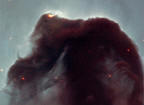|
> Dark Nebula
|
A dark nebula is a large cloud which appears as star-poor regions where the dust of interstellar medium seems to be concentrated. Dark nebulae can be seen if they obscure part of an emission or
reflection nebula (eg. the Horsehead Nebula) or if they block out
background stars (eg. the Coalsack Nebula).
The hydrogen of these opaque dark clouds exists in the form of
molecular hydrogen. The largest nebulae of this type, the so-called giant
molecular clouds (GMC), are more than a million times as massive as the
Sun. They contain much of the mass of the interstellar medium, are some
150 light-years across, and have an average density of 100 to 300
molecules per cubic centimetre and an internal temperature of only 7 to 15
K. Molecular clouds consist mainly of gas and dust but contain many stars
as well. The cloud cores are completely hidden from view and would be
undetectable except for the microwave emissions from their constituent
molecules. This radiation is not absorbed by dust and readily escapes the
cloud. The material within the clouds is clumped together in all sizes,
with some clouds ranging down to the masses of individual stars, small
clumps may extend about one light-year across. The clouds have an internal
magnetic field that provides support against their own gravity.
|
